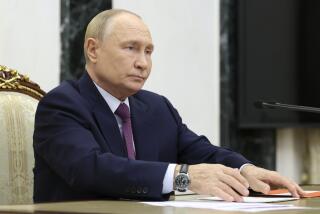Soviets Link ‘Star Wars,’ Long-Range Missile Pact
- Share via
GENEVA — The Soviet Union on Friday presented a draft treaty calling for the two superpowers to cut their long-range nuclear arsenals in half, but it linked an accord to limits on the Strategic Defense Initiative, known as “Star Wars.”
The Kremlin set forth its formal position at a joint plenary meeting of the Geneva arms talks, held at the U.S. mission. The Soviet draft calls for the 50% reduction to be achieved in five years.
In Washington, State Department spokesman Charles Redman termed the Soviet draft “a welcome step forward from the past Soviet approach of proposing highly generalized documents containing only basic principles.”
“Now that we each have a treaty on the table we can begin the sustained effort necessary to put together a joint draft text and negotiate the remaining differences,” Redman said.
If both sides work diligently, a treaty could be formulated this year, he added.
The United States presented a treaty on long-range arms in May that also called for 50% reductions, but over seven years. The two sides also disagree on how to implement the reductions.
More Verification Details
The chief U.S. delegate on strategic weapons, Ronald F. Lehman, told a news conference after the session that the Soviet draft contains no changes of position on major issues.
He said the draft contains “more details” on verification measures than past Soviet statements. But he said, “It’s obvious to me in looking at the Soviet proposal that we’re not there (at agreement) yet.”
Still, he said, the Soviet proposal could contribute to progress in the negotiations.
Strategic arms, which include land-based and submarine-based intercontinental ballistic missiles and long-range bombers, represent one area under discussion in the three-part Geneva talks. The other areas are intermediate-range nuclear forces (INF) and space and defense systems.
The Soviets have insisted on linking agreement in the strategic and space and defense areas. Earlier this year, they separated the intermediate category, which includes medium- and shorter-range missiles, focusing attention on that area as the most likely to produce agreement.
On Wednesday, the Soviets put forth a draft agreement in the space and defense area that called for a strengthening of the anti-ballistic missile system and prevention of an arms race in space. Included in that draft was a demand for restrictions on the Strategic Defense Initiative.
Alexei A. Obukhov, the deputy chief Soviet negotiator, said Friday that such an agreement “is a necessary prerequisite” for an agreement on long-range weapons.
“One cannot reduce strategic offensive arms with one hand and prepare a new lethal danger for mankind--this time from outer space--with the other,” Obukhov said.
Speaking separately, Lehman said, “This is not a reasonable linkage. It creates obstacles. We need to limit offensive arms.”
The Soviet proposal calls for a reduction in strategic nuclear weapons to 1,600 on each side, with a limit of 6,000 warheads. The two sides agreed on these numbers at the Reykjavik summit, and they also are included in the U.S. draft.
But the United States wants to impose “sublimits” on the three types of weapons included in the strategic category to prevent one country from concentrating its forces in one area.
The Soviets, whose strategic offensive weapons are primarily land-based missiles, oppose this because they say it will force them to restructure their forces.
More to Read
Sign up for Essential California
The most important California stories and recommendations in your inbox every morning.
You may occasionally receive promotional content from the Los Angeles Times.













